Equimetrix Device: Criteria Based Validation and Reliability Analysis of the Center of Mass and Base of Support of a Human Postural Assessment System
Abstract
1. Introduction
2. Materials and Methods
2.1. Participants
2.2. The Equimetrix Measuring System
2.3. Experimental Setup and Data Collection Procedures
2.3.1. Center of Mass and Center of Pressure
2.3.2. Base of Support
2.3.3. System Synchronization
2.4. Data Processing and Analysis
2.4.1. Center of Mass and Center of Pressure Analysis
2.4.2. Center of Mass Height Correction
2.4.3. Base of Support Analysis
2.5. Statistical Analysis
3. Results
3.1. Center of Mass Height Correction
3.2. Center of Mass and Center of Pressure
3.3. Base of Support
3.4. Relative Biomechanical Feature Variations
4. Discussion
4.1. Center of Mass and Center of Pressure
4.2. Base of Support
4.3. Study Limitations
5. Conclusions
Author Contributions
Funding
Institutional Review Board Statement
Informed Consent Statement
Data Availability Statement
Acknowledgments
Conflicts of Interest
References
- Almeida, G.; Monteiro, I.; Marizeiro, D.; Maia, L.; Lima, P. Y balance test has no correlation with the Stability Index of the Biodex Balance System. Musculoskelet. Sci. Pract. 2017, 27, 1–6. [Google Scholar] [CrossRef] [PubMed]
- Dawson, N.; Dzurino, D.; Karleskint, M.; Tucker, J. Examining the reliability, correlation, and validity of commonly used assessment tools to measure balance. Health Sci. Rep. 2018, 1, e98. [Google Scholar] [CrossRef] [PubMed]
- Delahunt, E.; Monaghan, K.; Caulfield, B. Altered Neuromuscular Control and Ankle Joint Kinematics During Walking in Subjects With Functional Instability of the Ankle Joint. Am. J. Sports Med. 2006, 34, 1970–1976. [Google Scholar] [CrossRef] [PubMed]
- Lord, S.; Sherrington, C.; Menz, H.; Close, J. Falls in Older People: Risk Factors and Strategies for Prevention, 2nd ed.; Cambridge University Press: Cambridge, UK, 2007; ISBN 978-1107320055. [Google Scholar]
- El-Khoury, F.; Cassou, B.; Charles, M.A.; Dargent-Molina, P. The effect of fall prevention exercise programmes on fall induced injuries in community dwelling older adults: Systematic review and meta-analysis of randomised controlled trials. BMJ 2013, 347, f6234. [Google Scholar] [PubMed]
- Greve, J.; Cug, M.; Dülgeroglu, D.; Brech, G.; Alonso, A. Relationship between Anthropometric Factors, Gender, and Balance under Unstable Conditions in Young Adults. Biomed Res. Int. 2013. [Google Scholar] [CrossRef]
- Meyer, G.; Ayalon, M. Biomechanical aspects of dynamic stability. Eur. Rev. Aging Phys. Act. 2006, 3, 29–33. [Google Scholar] [CrossRef]
- Hur, P.; Pan, Y.T.; DeBuys, C. Free Energy Principle in Human Postural Control System: Skin Stretch Feedback Reduces the Entropy. Sci. Rep. 2019, 9, 16870. [Google Scholar] [CrossRef]
- Duarte, M.; Freitas, S. Revision of posturography based on force plate for balance evaluation. Braz. J. Phys. Ther. 2010, 14, 183–192. [Google Scholar] [CrossRef]
- Paillard, T.; Noé, F. Techniques and Methods for Testing the Postural Function in Healthy and Pathological Subjects. Biomed. Res. Int. 2015, 2015, 891390. [Google Scholar] [CrossRef]
- Prieto, T.; Myklebust, J.; Myklebust, B. Characterization and Modeling of Postural Steadiness in the Elderly: A Review. IEEE Trans. Rehabil. Eng. 1993, 1, 26–34. [Google Scholar] [CrossRef]
- King, D.; Zatsiorsky, V. Extracting gravity line displacement from stabilographic recordings. Gait Posture 1997, 6, 27–38. [Google Scholar] [CrossRef]
- Collins, J.J.; de Luca, C.J. Open-loop and closed-loop control of posture: A random-walk. Exp. Brain Res. 1993, 95, 308–3018. [Google Scholar] [CrossRef] [PubMed]
- Pereira, C.; Silva, R.A.; Oliveira, M.R.; Souza, R.D.; Borges, R.J.; Vieira, E.R. Effect of Body Mass Index and Fat Mass on Balance Force Platform Measurements during a One-Legged Stance in Older Adults. Aging Clin. Exp. Res. 2018, 30, 441–447. [Google Scholar] [CrossRef] [PubMed]
- Cimandoro, G.; Paizis, C.; Alberti, G.; Babault, N. Effects of different unstable supports on EMG activity and balance. Neurosci. Lett. 2013, 548, 228–232. [Google Scholar] [CrossRef] [PubMed]
- Gribble, P.; Hertel, J.; Plinsky, P. Using the star excursion balance test to assess dynamic postural-control déficits and outcomes in lower extremity injury: A literature and systematic review. J. Athl. Train. 2012, 47, 339–357. [Google Scholar] [CrossRef] [PubMed]
- Coughlan, G.; Fullam, K.; Delahunt, E.; Gissane, C.; Caulfield, B. A comparison between performance on selected directions of the star excursion balance test and the Y Balance test. J. Athl. Train. 2002, 47, 366–371. [Google Scholar] [CrossRef]
- Williams, M.; Soiza, R.; Jenkinson, A.; Stewart, A. EXercising With Computers in Later Life (EXCELL)—Pilot and Feasibility Study of the Acceptability of the Nintendo® WiiFit in Community-Dwelling Fallers. BMC Res. Notes 2010, 3, 238. [Google Scholar] [CrossRef]
- Bonnechère, B.; Jansen, B.; Van Sint, J. Cost-effective (gaming) motion and balance devices for functional assessment: Need of hype. J. Biomech. 2016, 49, 2561–2565. [Google Scholar] [CrossRef]
- Bernhard, F.P.; Sartor, J.; Bettecken, K.; Hobert, M.A.; Arnold, C.; Weber, Y.G.; Poli, S.; Margraf, N.G.; Schlenstedt, C.; Hansen, C.; et al. Wearable for gait and balance assessment in the neurological ward—Study design and first results of a prospective cross-sectional feasibility study with 384 patients. BMC Neurol. 2018, 18, 114. [Google Scholar] [CrossRef]
- Baud-Bovy, G.; Tatti, F.; Borghese, N. Ability of Low-Cost Force-Feedback Device to Influence Postural Stability. IEEE Trans. Haptics 2015, 8, 130–139. [Google Scholar] [CrossRef]
- Audiffren, J.; Contal, E. Preprocessing the Nintendo wii board signal to derive more accurate descriptor of statokinesigrams. Sensors 2016, 16, 1208. [Google Scholar] [CrossRef] [PubMed]
- Castelli, L.; Stocchi, L.; Patrignani, M.; Sellitto, G.; Giuliani, M.; Prosperini, L. We-Measure. Towards a low-cost portable posturography for patients with multiple sclerosis using the commercial Wii Balance Board. J. Neurol. Sci. 2015, 359, 440–444. [Google Scholar] [CrossRef] [PubMed][Green Version]
- Chang, J.; Levy, S.; Seay, S.; Goble, D. An alternative to the Balance Error Scoring System: Using a low-cost balance board to improve the validity/reliability of sports-related concussion balance testing. Clin. J. Sport Med. 2014, 24, 256–262. [Google Scholar] [CrossRef] [PubMed]
- Clark, R.A.; Mentiplay, B.F.; Pua, Y.; Bower, K.J. Reliability and validity of the Wii Balance Board for assessment of standing balance: A systematic review. Gait Posture 2018, 61, 40–54. [Google Scholar] [CrossRef] [PubMed]
- Hou, Y.; Chiu, Y.; Chiang, S.; Chen, H.; Sung, W. Development of a Smartphone-Based Balance Assessment System for Subjects with Stroke. Sensors 2020, 20, 88. [Google Scholar] [CrossRef]
- Clark, R.A.; Bower, K.J.; Mentiplay, B.F.; Paterson, K.; Pua, Y. Concurrent validity of the Microsoft Kinect for assessment of spatiotemporal gait variables. J. Biomech. 2013, 46, 2722–2725. [Google Scholar] [CrossRef]
- Mentiplay, B.F.; Perraton, L.G.; Bower, K.J.; Pua, Y.; McGaw, R.; Heywood, S.; Clark, R.A. Gait assessment using the Microsoft Xbox One Kinect: Concurrent validity and inter-day reliability of spatiotemporal and kinematic variables. J. Biomech. 2015, 48, 2166–2170. [Google Scholar] [CrossRef]
- Grobelny, A.; Behrens, J.R.; Mertens, S.; Otte, K.; Mansow-Model, S.; Krüger, T.; Gusho, E.; Bellmann-Strobl, J.; Paul, F.; Brandt, A.U.; et al. Maximum walking speed in multiple sclerosis assessed with visual perceptive computing. PLoS ONE 2017, 12, e0189281. [Google Scholar] [CrossRef]
- Clark, R.A.; Pua, Y.; Fortin, K.; Ritchie, C.; Webster, K.E.; Denehy, L.; Bryant, A.L. Validity of the Microsoft Kinect for assessment of postural control. Gait Posture 2012, 36, 372–377. [Google Scholar] [CrossRef]
- Clark, R.A.; Pua, Y.; Oliveira, C.C.; Bower, K.J.; Thilarajah, S.; McGaw, R.; Hasanki, K.; Mentiplay, B.F. Reliability and concurrent validity of the Microsoft Xbox One Kinect for assessment of standing balance and postural control. Gait Posture 2015, 42, 210–213. [Google Scholar] [CrossRef]
- Behrens, J.R.; Mertens, S.; Krüger, T.; Grobelny, A.; Otte, K.; Mansow-Model, S.; Gusho, E.; Paul, F.; Brandt, A.U.; Schmitz-Hübsch, T. Validity of visual perceptive computing for static posturography in patients with multiple sclerosis. Mult. Scler. 2016, 22, 1596–1606. [Google Scholar] [CrossRef] [PubMed]
- Xu, X.; McGorry, R.W. The validity of the first and second generation Microsoft Kinect for identifying joint center locations during static postures. Appl. Ergon. 2015, 49, 47–54. [Google Scholar] [CrossRef] [PubMed]
- Bonnechere, B.; Sholukha, V.; Jansen, B.; Omelina, L.; Rooze, M.; Van Sint Jan, S. Determination of Repeatability of Kinect Sensor. Telemed. J. e-Health 2014, 20, 451–453. [Google Scholar] [CrossRef] [PubMed]
- Vilas-Boas, M.C.; Choupina, H.M.; Rocha, A.P.; Fernandes, J.M.; Cunha, J.P. Full-body motion assessment: Concurrent validation of two body tracking depth sensors versus a gold standard system during gait. J. Biomech. 2019, 87, 189–196. [Google Scholar] [CrossRef] [PubMed]
- Hof, A.L. The ‘extrapolated center of mass’ concept suggests a simple control of balance in walking. Hum. Mov. Sci. 2008, 27, 112–125. [Google Scholar] [CrossRef]
- Hasson, C.J.; Emmerik, R.E.; Caldwell, G.E. Predicting dynamic postural instability using center of mass time-to-contact information. J. Biomech. 2008, 41, 2121–2129. [Google Scholar] [CrossRef] [PubMed]
- de Jong, L.A.; van Dijsseldonk, R.B.; Keijsers, N.L.; Groen, B.E. Test-retest reliability of stability outcome measures during treadmill walking in patients with balance problems and healthy controls. Gait Posture 2020, 76, 92–97. [Google Scholar] [CrossRef] [PubMed]
- Hahn, M.E.; Chou, L.S. Age-related reduction in sagittal plane center of mass motion during obstacle crossing. J. Biomech. 2004, 37, 837–944. [Google Scholar] [CrossRef] [PubMed]
- Pai, Y.C.; Patton, J. Center of mass velocity-position predictions for balance control. J. Biomech. 1997, 30, 347–354. [Google Scholar] [CrossRef]
- Winter, D.A. Anthropometry. In Biomechanics and Motor Control of Human Movement, 3rd ed.; John Wiley & Sons: Hoboken, NJ, USA, 2004; pp. 63–64. ISBN 978-0471449898. [Google Scholar]
- Silva, M.G.; Moreira, P.V.; Rocha, H.M. Development of a low cost force platform for biomechanical parameters analysis. Res. Biomed. Eng. 2017, 33, 259–268. [Google Scholar] [CrossRef]
- Chiari, L.; Rochhi, L.; Cappello, A. Stabilometric parameters are affected by anthropometry and foot placement. Clin. Biomech. 2002, 17, 666–677. [Google Scholar] [CrossRef]
- Oliveira, J.M. Statokinesigram normalization method. Behav. Res. Methods 2017, 49, 310–317. [Google Scholar] [CrossRef] [PubMed]
- Schubert, P.; Kirchner, M.; Schmidtbleicher, D.; Haas, C. About the structure of posturography: Sampling duration, parametrization, focus of attention (part I). J. Biomed. Sci. Eng. 2012, 5, 496–507. [Google Scholar] [CrossRef]
- Faul, F.; Erdfelder, E.; Lang, A.; Buchner, A. G*Power 3: A flexible statistical power analysis program for the social, behavioral, and biomedical sciences. Behav. Res. Methods 2007, 39, 175–191. [Google Scholar] [CrossRef] [PubMed]
- Cohen, J. Statistical Power Analysis for the Behavioral Sciences, 2nd ed.; Lawrence Erlbaum Associates: Mahwah, NJ, USA, 1988; pp. 25–26. ISBN 0805802835. [Google Scholar]
- Sawilowsky, S. New Effect Size Rules of Thumb. J. Mod. Appl. Stat. Methods 2009, 8, 597–599. [Google Scholar] [CrossRef]
- Youdas, J.W.; Carey, J.R.; Garrett, T. Reliability of measurements of cervical spine range of motion—Comparison of three methods. Phys. Ther. 1991, 71, 98–104. [Google Scholar] [CrossRef]
- Portney, L.G.; Watkins, M.P. Foundations of Clinical Research: Applications to Practice, 3rd ed.; F.A. Davis Company: Philadelphia, PA, USA, 2015; ISBN 978-0131716407. [Google Scholar]
- Gurfinkel, V.S.; Osevets, M. Dynamics of the vertical posture in man. Biophysics 1972, 17, 496–506. [Google Scholar]
- Brumagne, S.; Cordo, P.; Verschueren, S. Proprioceptive weighting changes in persons with low back pain and elderly persons during upright standing. Neurosci. Lett. 2004, 366, 63–66. [Google Scholar] [CrossRef]
- Masami, K.; Vette, A.; Abe, M.; Nakazawa, K. Center of pressure velocity reflects body acceleration rather than body velocity during quiet standing. Gait Posture 2014, 39, 946–952. [Google Scholar] [CrossRef]
- Angin, S.; Simsek, I. Comparative Kinesiology of the Human Body: Normal and Pathological Conditions; Elsevier Science: Amsterdam, The Netherlands, 2020; ISBN 978-0-12-812162-7. [Google Scholar]
- Harringe, M.L.; Halvorsen, K.; Renström, P.; Werner, P. Postural control measured as the center of pressure excursion in young female gymnasts with low back pain or lower extremity injury. Gait Posture 2008, 28, 38–45. [Google Scholar] [CrossRef]
- Kim, J.W.; Kwon, Y.; Jeon, H.M.; Bang, M.J.; Jun, J.H.; Eom, G.M.; Lim, D.H. Feet distance and static postural balance: Implication on the role of natural stance. Biomed. Mater. Eng. 2014, 24, 2681–2688. [Google Scholar] [CrossRef] [PubMed]
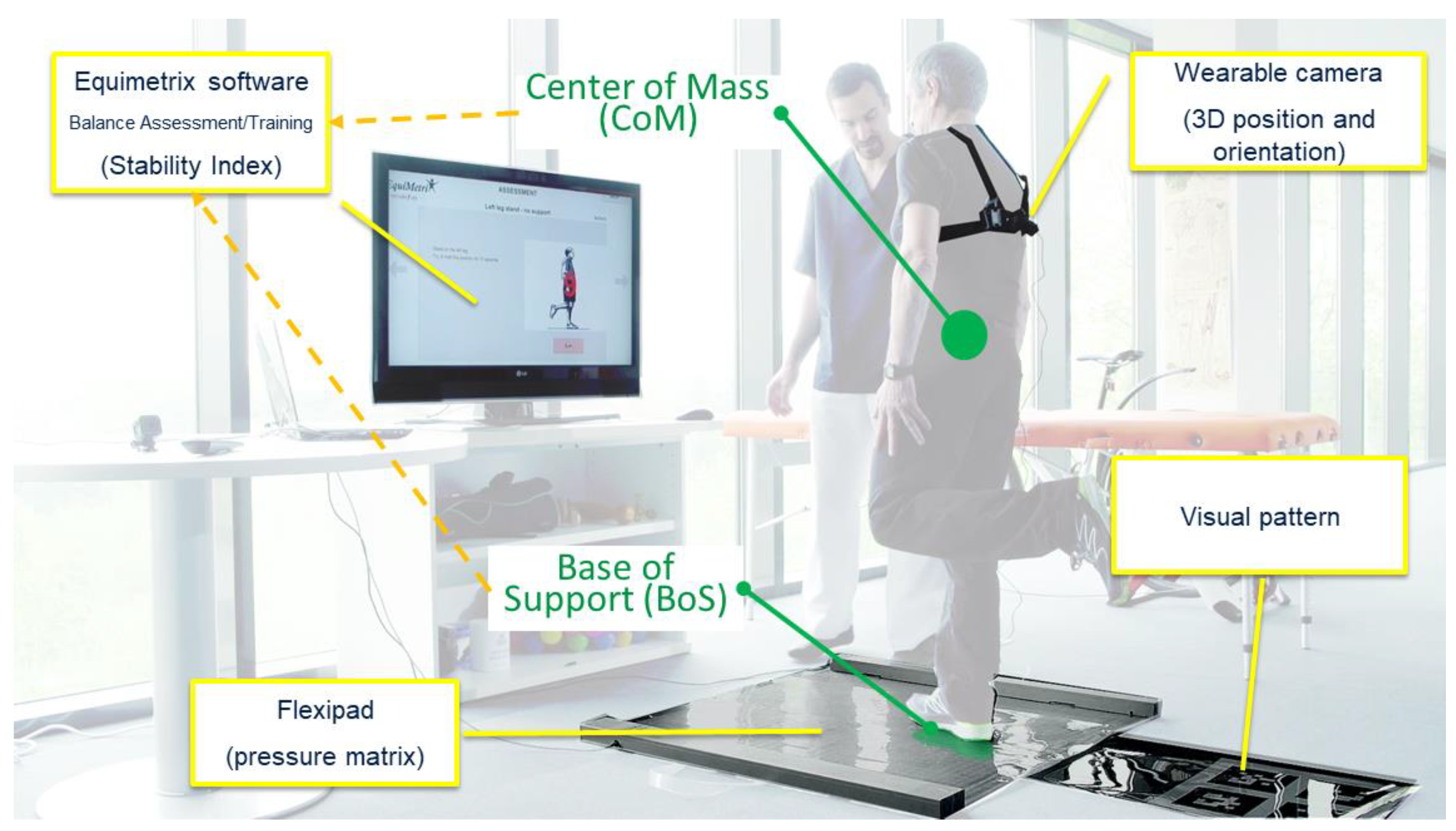

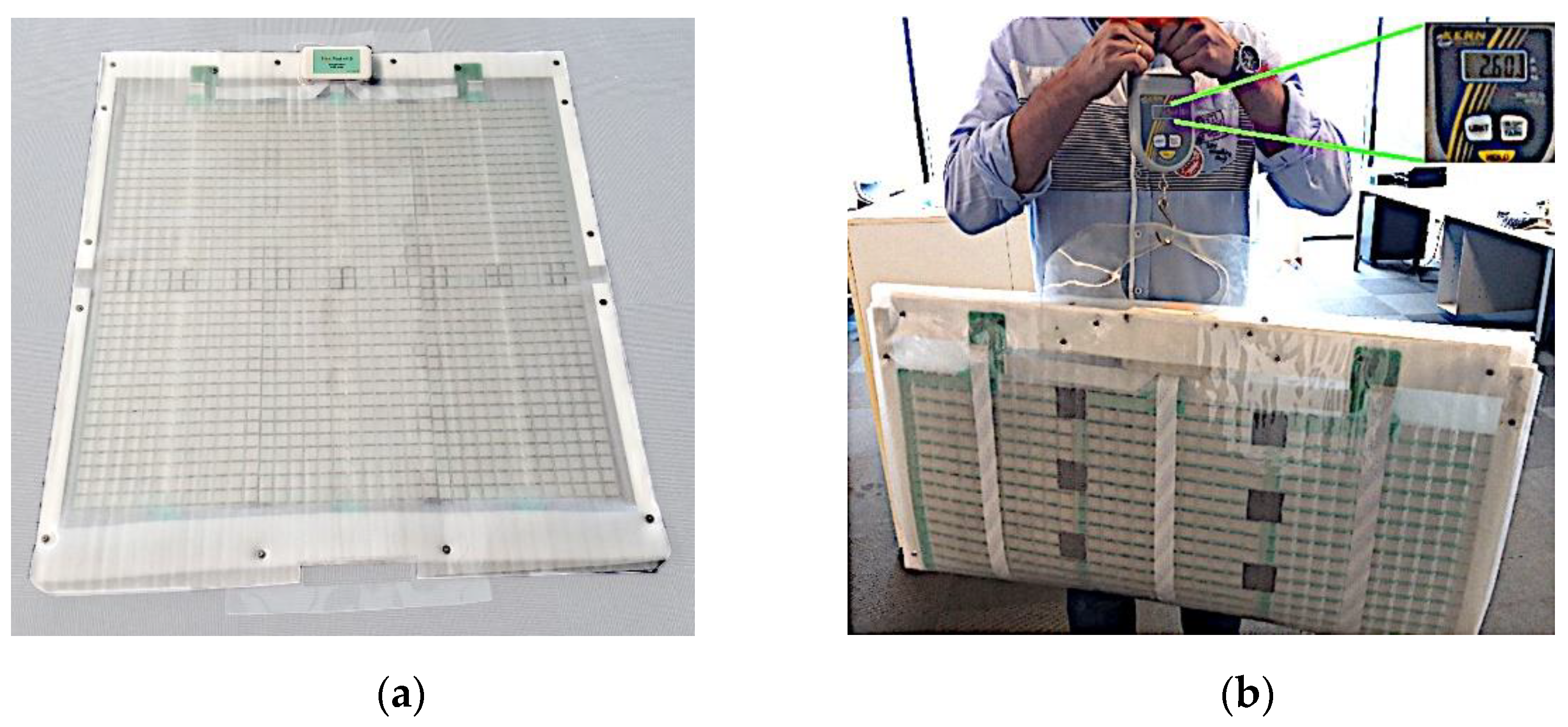
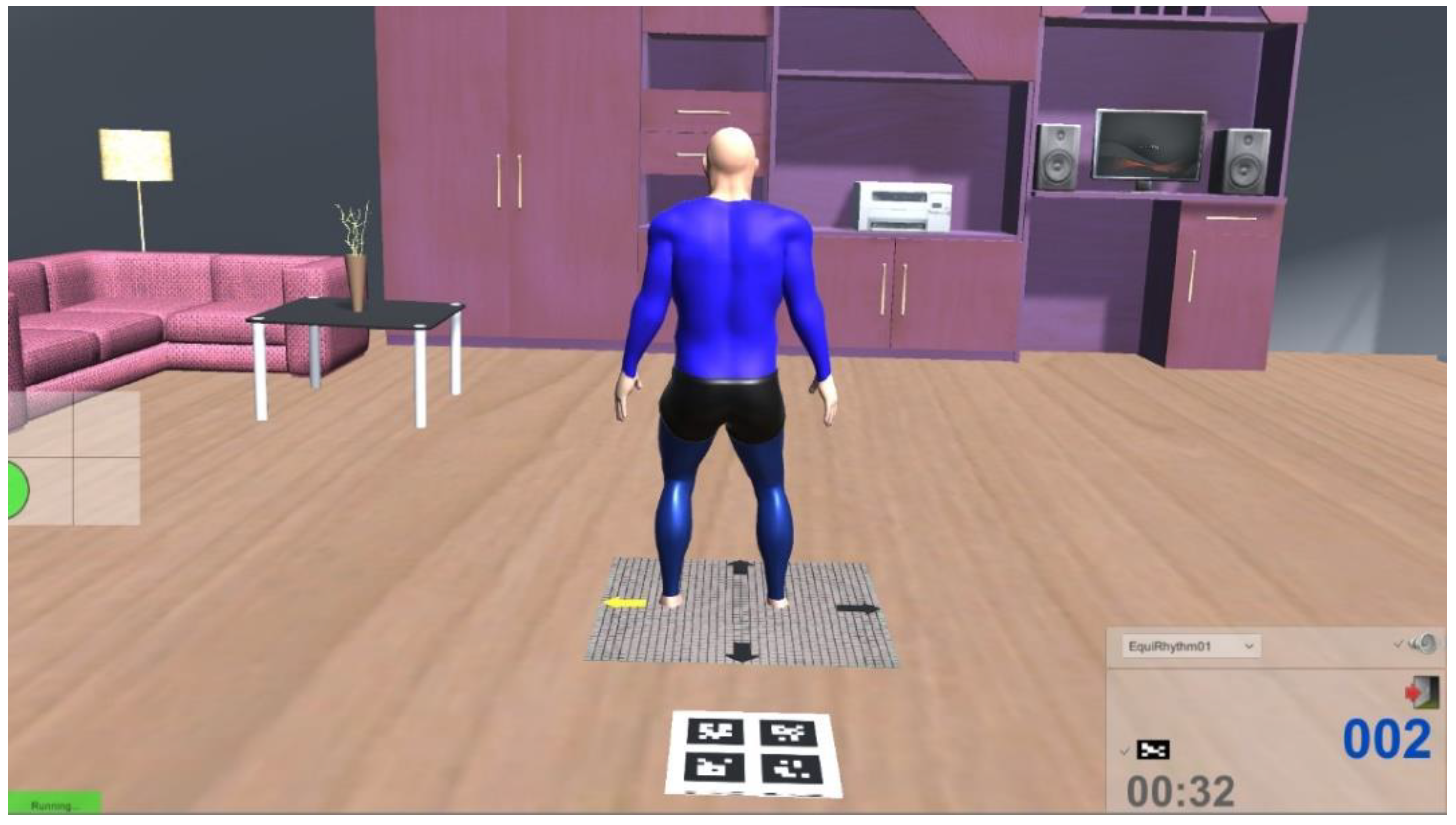

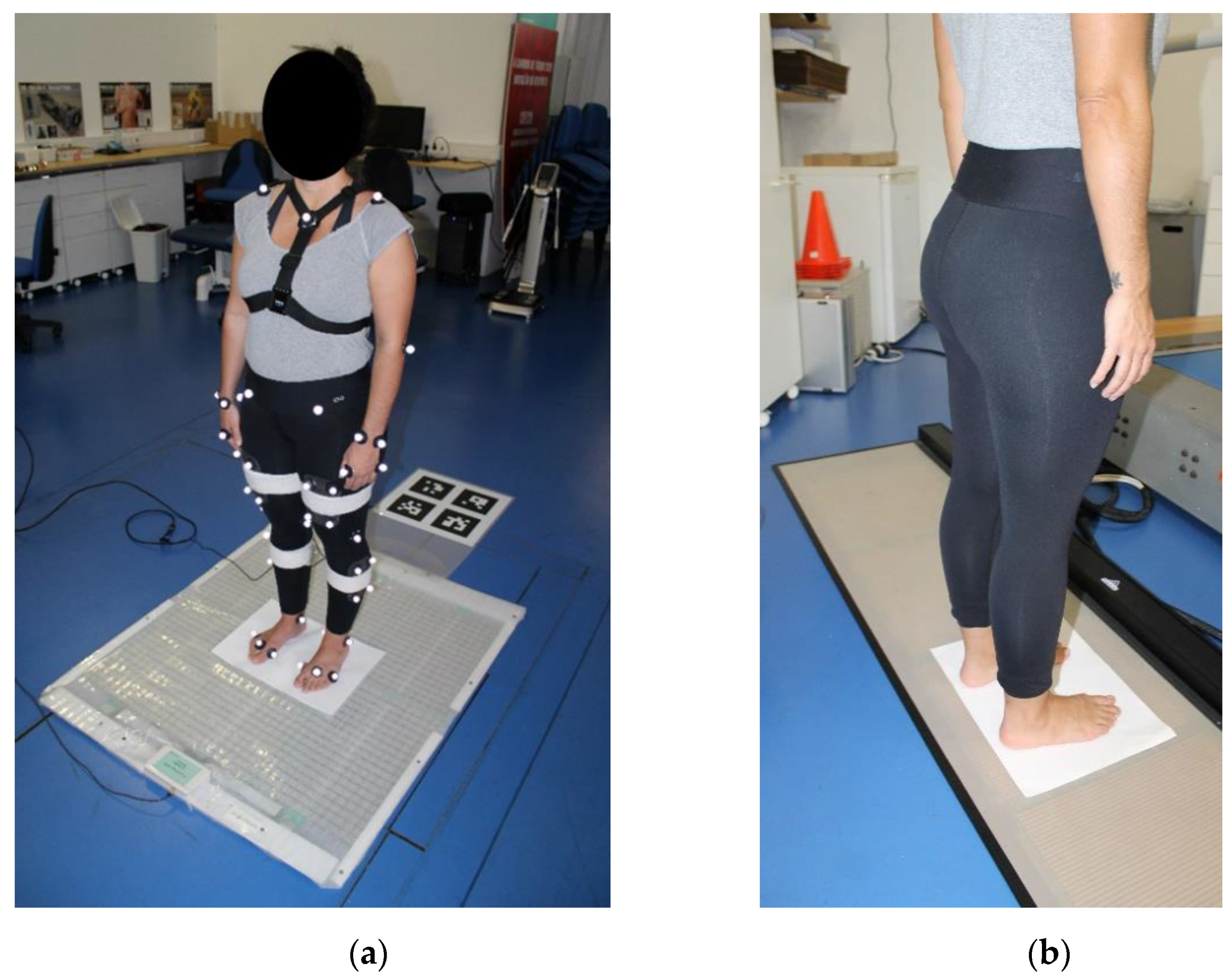
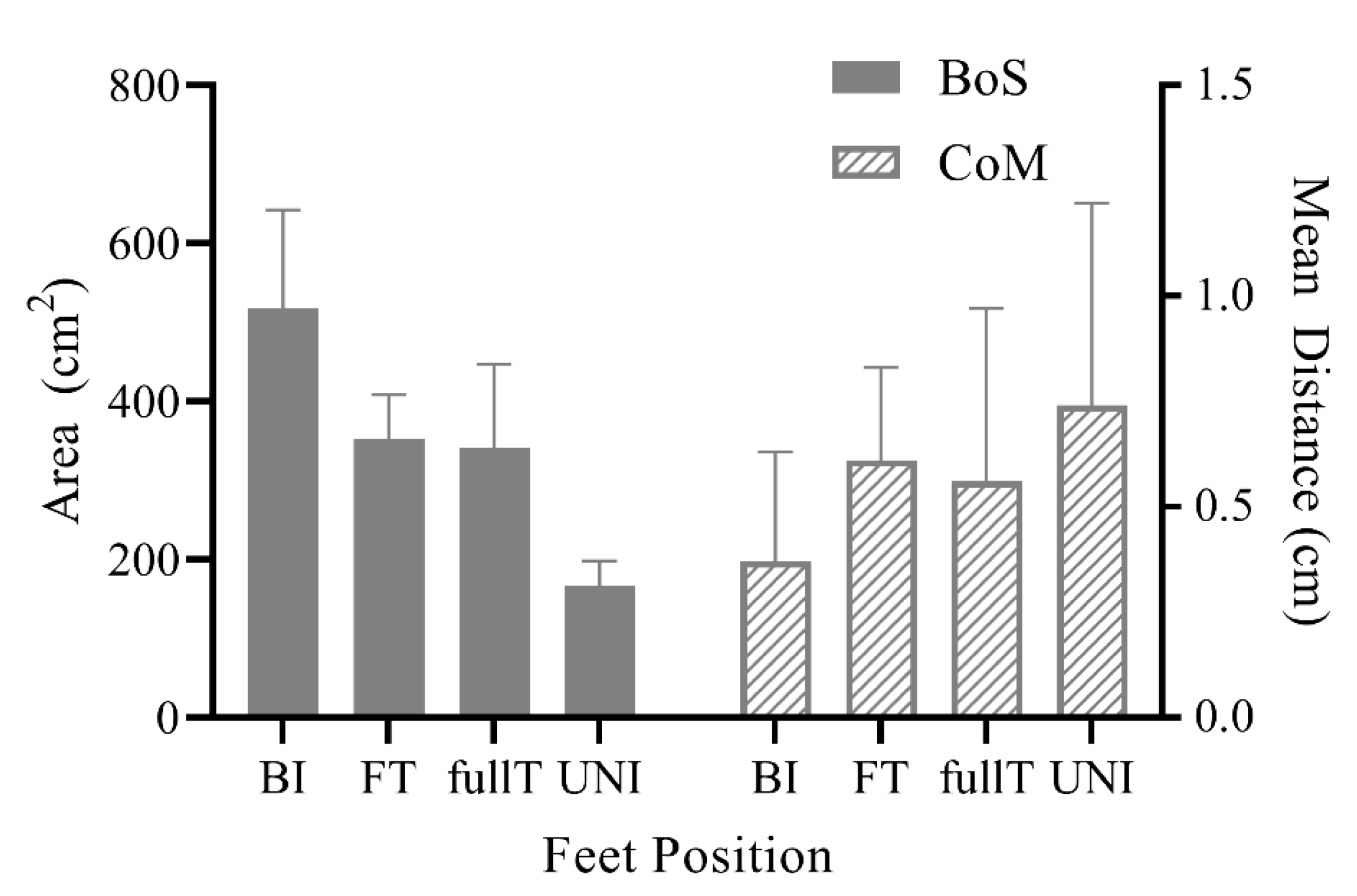
| Biomechanical Measurements | Functional Tasks | ||||||
|---|---|---|---|---|---|---|---|
| CoP | CoM | BoS | CoM + BoS | Static Standing | Dynamic Standing | Stepping Response | |
| Dynamometric and Stabilometric devices | √ | √ | √ | ||||
| Baropodometric device | √ | √ | √ | √ | √ | ||
| Motion capture Systems | √ | √ | √ | √ | |||
| Inertial measurement units | √ | √ | √ | √ | |||
| Equimetrix | √ | √ | √ | √ | √ | √ | |
| Position | Source | CoM Height (cm) | CoM Adjusted (cm) | Sway Angle Range (°) | Sway Angle RMS (°) | ||
|---|---|---|---|---|---|---|---|
| AP | ML | AP | ML | ||||
| BI | K_CoM | 92.5 (5.9) | - | 47.1 ± 11.6 | 21.8 (9.4) | 14.8 (6.4) | 5.1 (2.8) |
| E_CoM | 117.3 (8.8) | 92.9 (5.4) | 52.3 (11.5) | 34.0 (15.5) | 16.2 (6.3) | 7.7 (4.2) | |
| FT | K_CoM | 92.4 (5.9) | - | 49.0 (9.2) | 51.7 (8.3) | 14.6 (4.6) | 15.7 (4.1) |
| E_CoM | 117.7 (9.2) | 92.2 (5.9) | 51.7 (9.2) | 54.9 (9.1) | 15.5 (5.1) | 17.0 (5.1) | |
| fullT | K_CoM | 91.2 ± 6.4 | - | 53.4(14.3) | 57.1 (7.7) | 20.0 (11.8) | 19.4 (7.8) |
| E_CoM | 115.8 (9.7) | 91.0 (6.8) | 56.9 (8.5) | 56.9 (8.5) | 24.3 (15.9) | 19.6 (9.2) | |
| UNI | K_CoM | 93.4 ± 5.9 | - | 60.0 (9.7) | 55.0 (7.8) | 23.6 (9.7) | 17.5 (4.4) |
| E_CoM | 118.2 (8.4) | 92.6 (5.2) | 62.1 (8.2) | 59.3 (8.7) | 25.1 (9.0) | 18.6 (4.9) | |
| Position | Statistics | CoM Height | Sway Angle Range | Sway Angle RMS | ||
|---|---|---|---|---|---|---|
| AP | ML | AP | ML | |||
| BI | t/U | 4.00 | −1.50 | 101.00 | 164.00 | 114.00 |
| p | <0.01 | 0.14 | <0.01 | 0.34 | 0.02 | |
| Power | 1.00 | 0.31 | 0.81 | 0.16 | 0.68 | |
| Cohen’s d | 3.21 | 0.47 | 0.95 | 0.32 | 0.80 | |
| FT | t/U | 3.00 | 136.00 | 127.00 | 147.00 | 140.00 |
| p | <0.01 | 0.42 | 0.28 | 0.65 | 0.50 | |
| Power | 1.00 | 0.13 | 0.19 | 0.07 | 0.10 | |
| Cohen’s d | 3.23 | 0.28 | 0.38 | 0.16 | 0.24 | |
| fullT | t/U | 1.94 | 120.00 | 143.00 | 126.00 | 132.00 |
| p | <0.01 | 0.41 | 0.97 | 0.54 | 0.68 | |
| Power | 1.00 | 0.13 | 0.05 | 0.09 | 0.07 | |
| Cohen’s d | 3.00 | 0.30 | 0.02 | 0.22 | 0.15 | |
| UNI | t/U | −9.67 | 107.00 | 90.00 | 110.00 | 109.00 |
| p | <0.01 | 0.45 | 0.16 | 0.52 | 0.49 | |
| Power | 1.00 | 0.12 | 0.30 | 0.10 | 0.11 | |
| Cohen’s d | 3.42 | 0.29 | 0.53 | 0.25 | 0.26 | |
| Position | Source | Mean Path Velocity (cm/s) | Range (cm) | RMS (cm) | ||||||
|---|---|---|---|---|---|---|---|---|---|---|
| AP | ML | V | AP | ML | V | AP | ML | V | ||
| BI | K_CoM | 0.21 (0.10) C | 0.1 (0.09) D | 0.05 (0.03) D | 1.77 (1.12) A1 | 0.55 (0.70) D | 0.24 (0.16) D | 0.39 (0.33) A1 | 0.11 (0.17) C1 | 92.16 (9.01) A1 |
| F_CoP | 0.32 (0.12) C2 | 0.2 (0.10) D | NA | 1.97 (1.00) B1 | 0.75 (0.71) C1 | NA | 0.37 (0.26) A1 | 0.13 (0.17) C2 | NA | |
| E_CoM | 0.43 (0.14) | 0.44 (0.43) | 0.46 (0.29) | 2.26 (1.65) | 0.81 (1.03) | 0.9 (0.78) | 0.41 (0.29) | 0.16 (0.21) | 91.93 (6.19) | |
| FT | K_CoM | 0.26 (0.10) C2 | 0.32 (0.14) C2 | 0.05 (0.02) D | 1.81 (1.27) B1 | 1.94 (0.93) A1 | 0.26 (0.27) C | 0.39 (0.21) A1 | 0.41 (0.21) A1 | 91.43 (11.07) A1 |
| F_CoP | 0.35 (0.18) C2 | 0.5 (0.15) C2 | NA | 2.04 (0.97) B1 | 2.22 (1.22) B1 | NA | 0.39 (0.17) A1 | 0.44 (0.22) A1 | NA | |
| E_CoM | 0.42 (0.15) | 0.57 (0.54) | 0.38 (0.11) | 2.23 (1.06) | 2.32 (1.38) | 0.7 (0.29) | 0.44 (0.17) | 0.48 (0.26) | 91.89 (6.13) | |
| fullT | K_CoM | 0.25 (0.13) C | 0.39 (0.15) D2 | 0.09 (0.04) D | 1.97 (1.92) A1 | 2.52 ± 0.63A | 0.63 (0.44) D | 0.43 (0.45) A1 | 0.52 ± 0.17 A | 90.4 (9.52) B1 |
| F_CoP | 0.42 (0.22) C | 0.63 (0.19) C | NA | 2.11 (2.62) A1 | 2.97 ± 0.89 C | NA | 0.43 (0.39) A1 | 0.56 ± 0.16 A | NA | |
| E_CoM | 0.42 (0.21) | 0.46 (0.23) | 0.36 (0.72) | 1.95 (1.6) | 2.46 ± 0.77 | 1.12 (1.27) | 0.41 (0.40) | 0.49 ± 0.17 | 90.72 (7.23) | |
| UNI | K_CoM | 0.46 ± 0.11 C3 | 0.42 (0.08) D | 0.09 (0.07) D | 2.57 (2.41) A1 | 2.01 (0.78) B1 | 0.78 (0.75) C | 0.59 (0.44) A1 | 0.44 (0.14) A1 | 92.02 (8.84) A1 |
| F_CoP | 0.78 ± 0.16 C4 | 0.76 (0.16) D | NA | 3.9 (3.44) A1 | 2.58 (0.93) B1 | NA | 0.67 (0.45) A1 | 0.49 (0.16) A1 | NA | |
| E_CoM | 0.66 ± 0.23 | 0.56 (0.32) | 0.45 (0.31) | 2.85 (2.26) | 2.33 (1.33) | 1.74 (1.15) | 0.65 (0.40) | 0.48 (0.24) | 92.85 (6.80) | |
| Position | Comparison | Statistics | Mean Path Velocity | Range | RMS | ||||||
|---|---|---|---|---|---|---|---|---|---|---|---|
| AP | ML | V | AP | ML | V | AP | ML | V | |||
| BI | K_CoM vs. E_CoM | t/U | 22.00 | 14.00 | 0.00 | 114.00 | 33.00 | 24.00 | 150.00 | 104.00 | 179.00 |
| p | <0.01 | <0.01 | <0.01 | 0.05 | 0.01 | <0.01 | 0.39 | 0.03 | 0.98 | ||
| Power | 1.00 | 1.00 | 1.00 | 0.57 | 0.83 | 1.00 | 0.15 | 0.70 | 0.05 | ||
| Cohen’s d | 2.34 | 2.66 | 3.47 | 0.67 | 0.93 | 2.28 | 0.24 | 0.79 | 0.01 | ||
| F_CoP vs. E_CoM | t/U | 65.00 | 76.00 | NA | 134.00 | 131.00 | NA | 149.00 | 129.00 | NA | |
| p | <0.01 | <0.01 | 0.18 | 0.15 | 0.37 | 0.14 | |||||
| Power | 0.99 | 0.96 | 0.30 | 0.34 | 0.16 | 0.36 | |||||
| Cohen’s d | 1.33 | 1.16 | 0.46 | 0.49 | 0.31 | 0.51 | |||||
| FT | K_CoM vs. E_CoM | t/U | 36.00 | 75.00 | 0.00 | 143.00 | 135.00 | 23.00 | 162.00 | 152.00 | 173.00 |
| p | <0.01 | <0.01 | <0.01 | 0.28 | 0.19 | <0.01 | 0.60 | 0.42 | 0.84 | ||
| Power | 1.00 | 0.96 | 1.00 | 0.21 | 0.29 | 1.00 | 0.09 | 0.14 | 0.06 | ||
| Cohen’s d | 1.93 | 1.17 | 3.47 | 0.37 | 0.45 | 2.31 | 0.18 | 0.28 | 0.07 | ||
| F_CoP vs. E_CoM | t/U | 123.00 | 150.00 | NA | 169.00 | 178.00 | NA | 169.00 | 180.00 | NA | |
| p | 0.10 | 0.39 | 0.75 | 0.95 | 0.75 | 1.00 | |||||
| Power | 0.44 | 0.15 | 0.06 | 0.05 | 0.06 | 0.05 | |||||
| Cohen’s d | 0.57 | 0.30 | 0.11 | 0.02 | 0.11 | 0.01 | |||||
| fullT | K_CoM vs. E_CoM | t/U | 30.00 | 60.00 | 1.00 | 85.00 | NA | 37.00 | 94.00 | NA | 98.00 |
| p | <0.01 | 0.09 | <0.01 | 0.57 | 1.00 | <0.01 | 0.87 | 1.00 | 1.00 | ||
| Power | 0.98 | 0.48 | 1.00 | 0.10 | 0.08 | 0.93 | 0.05 | 0.08 | 0.05 | ||
| Cohen’s d | 1.51 | 0.71 | 3.34 | 0.23 | 0.21 | 1.28 | 0.07 | 0.20 | 0.00 | ||
| F_CoP vs. E_CoM | t/U | 91.00 | 44.00 | NA | 84.00 | NA | NA | 95.00 | NA | NA | |
| p | 0.77 | 0.01 | 0.54 | 0.13 | 0.91 | 0.78 | |||||
| Power | 0.06 | 0.83 | 0.10 | 0.46 | 0.05 | 0.20 | |||||
| Cohen’s d | 0.12 | 1.09 | 0.25 | 0.79 | 0.05 | 0.47 | |||||
| UNI | K_CoM vs. E_CoM | t/U | NA | 32.00 | 2.00 | 83.00 | 66.00 | 31.00 | 92.00 | 81.00 | 92.00 |
| p | 0.04 | 0.01 | 0.01 | 0.51 | 0.15 | <0.01 | 0.80 | 0.45 | 0.80 | ||
| Power | 0.67 | 0.97 | 1.00 | 0.11 | 0.35 | 0.98 | 0.060 | 0.13 | 0.06 | ||
| Cohen’s d | −1.03 | 1.44 | 3.21 | 0.27 | 0.59 | 1.47 | 0.11 | 0.30 | 0.11 | ||
| F_CoP vs. E_CoM | t/U | NA | 47.00 | NA | 78.00 | 86.00 | NA | 90.00 | 86.00 | NA | |
| p | 0.39 | 0.02 | 0.38 | 0.60 | 0.73 | 0.60 | |||||
| Power | 0.26 | 0.77 | 0.16 | 0.09 | 0.07 | 0.09 | |||||
| Cohen’s d | 0.56 | 1.01 | 0.36 | 0.21 | 0.14 | 0.21 | |||||
| Position | Source | Mean Distance (cm) | Length (cm) | Ellipse Area (cm2) | Ellipse Long Axis (cm) | Ellipse Short Axis (cm) |
|---|---|---|---|---|---|---|
| BI | K_CoM | 0.35 (0.24) A1 | 12.57 (6.66) C | 0.86 (1.08) C1 | 0.95 (0.79) A1 | 0.27 (0.25) C |
| F_CoP | 0.35 (0.25) A | 19.36 (6.63) C | 1.11 (1.35) C1 | 0.90 (0.62) A1 | 0.32 (0.34) C2 | |
| E_CoM | 0.37 (0.26) | 33.10 (27.11) | 1.34 (2.67) | 1.00 (0.71) | 0.39 (0.46) | |
| FT | K_CoM | 0.53 (0.21) A1 | 20.13 (8.32) C2 | 3.03 (2.00) A1 | 1.16 (0.56) A1 | 0.78 (0.28) A1 |
| F_CoP | 0.56 (0.17) A1 | 30.58 (10.76) C2 | 3.38 (2.00) A1 | 1.20 (0.50) A1 | 0.82 (0.28) A1 | |
| E_CoM | 0.59 (0.20) | 39.91 (23.07) | 3.65 (2.39) | 1.29 (0.50) | 0.82 (0.36) | |
| fullT | K_CoM | 0.58 (0.46) A1 | 23.15 (10.25) D | 3.44 (6.99) A1 | 1.45 (0.99) A1 | 0.79 (0.8) A1 |
| F_CoP | 0.58 (0.40) A1 | 37.27 (13.88) C | 4.17 (6.27) A1 | 1.47 (0.96) A1 | 0.96 (0.56) A2 | |
| E_CoM | 0.56 (0.41) | 32.97 (14.89) | 3.55 (5.35) | 1.39 (0.94) | 0.79 (0.58) | |
| UNI | K_CoM | 0.66 (0.48) A1 | 27.53 (6.78) D | 4.92 (7.72) A1 | 1.49 (1.07) A1 | 0.95 (0.34) A1 |
| F_CoP | 0.73 (0.47) A1 | 50.61 (11.27) C | 6.66 (7.59) A1 | 1.70 (1.05) A1 | 1.12 (0.36) A1 | |
| E_CoM | 0.74 (0.48) | 35.86 (9.56) | 5.75 (8.06) | 1.68 (0.95) | 1.06 (0.51) |
| Position | Comparison | Statistics | Mean Distance | Length | Ellipse Area | Ellipse Long Axis | Ellipse Short Axis |
|---|---|---|---|---|---|---|---|
| BI | K_CoM vs. E_CoM | t/U | 136.00 | 11.00 | 120.00 | 145.00 | 106.00 |
| p | 0.20 | <0.01 | 0.08 | 0.31 | 0.03 | ||
| Power | 0.28 | 1.00 | 0.48 | 0.19 | 0.67 | ||
| Cohen’s d | 0.44 | 2.80 | 0.61 | 0.35 | 0.77 | ||
| F_CoP vs. E_CoM | t/U | 147.00 | 59.00 | 143.00 | 145.00 | 133.00 | |
| p | 0.34 | <0.01 | 0.28 | 0.31 | 0.17 | ||
| Power | 0.18 | 0.99 | 0.21 | 0.19 | 0.31 | ||
| Cohen’s d | 0.33 | 1.44 | 0.37 | 0.35 | 0.47 | ||
| FT | K_CoM vs. E_CoM | t/U | 149.00 | 43.00 | 148.00 | 146.00 | 161.00 |
| p | 0.37 | <0.01 | 0.35 | 0.33 | 0.58 | ||
| Power | 0.16 | 1.00 | 0.17 | 0.19 | 0.09 | ||
| Cohen’s d | 0.31 | 1.76 | 0.32 | 0.37 | 0.19 | ||
| F_CoP vs. E_CoM | t/U | 166.00 | 132.0 | 172.00 | 167.00 | 166.00 | |
| p | 0.69 | 0.16 | 0.82 | 0.71 | 0.69 | ||
| Power | 0.07 | 0.33 | 39.67 | 0.07 | 0.07 | ||
| Cohen’s d | 0.14 | 0.48 | 0.08 | 0.13 | 0.14 | ||
| fullT | K_CoM vs. E_CoM | t/U | 36.00 | 34.00 | 95.00 | 98.00 | 97.0 |
| p | 0.35 | <0.01 | 0.91 | 1.00 | 0.98 | ||
| Power | 0.05 | 0.96 | 0.05 | 0.05 | 0.05 | ||
| Cohen’s d | 0.04 | 1.37 | 0.05 | 0.000 | 0.02 | ||
| F_CoP vs. E_CoM | t/U | 86.00 | 63.00 | 85.0 | 87.00 | 79.00 | |
| p | 0.60 | 0.11 | 0.57 | 0.64 | 0.40 | ||
| Power | 0.07 | 0.09 | 0.41 | 0.10 | 0.08 | ||
| Cohen’s d | 0.16 | 0.21 | 0.65 | 0.23 | 0.20 | ||
| UNI | K_CoM vs. E_CoM | t/U | 91.00 | 20.00 | 81.00 | 94.00 | 78.00 |
| p | 0.77 | <0.01 | 0.45 | 0.87 | 0.38 | ||
| Power | 0.06 | 1.00 | 0.13 | 0.05 | 0.16 | ||
| Cohen’s d | 0.12 | 1.91 | 0.30 | 0.07 | 0.360 | ||
| F_CoP vs. E_CoM | t/U | 87.00 | 42.00 | 88.0 | 92.00 | 88.00 | |
| p | 0.64 | <0.01 | 0.67 | 0.80 | 0.67 | ||
| Power | 0.15 | 0.08 | 0.86 | 0.08 | 0.06 | ||
| Cohen’s d | 0.34 | 0.20 | 1.14 | 0.18 | 0.11 |
| Feet Position | Pressure Mat | Equimetrix | ||||
|---|---|---|---|---|---|---|
| Average Area (cm2) | Width (cm) | Length (cm) | Average Area (cm2) | Width (cm) | Length (cm) | |
| BI | 502.1 ± 78.58 C2 | 26.36 ± 2.32 A1 | 22.6 (2.5) B2 | 517.65 ± 124.32 | 26.97 ± 3 | 21.35 (5.1) |
| FT | 287.4 ± 48.01 A1 | 16.8 (2.3) B1 | 21.88 ± 2.49 C2 | 352.85 ± 55.09 | 17.5 (2.6) | 21.5 ± 1.78 |
| fullT | 305.1 ± 60.71 C2 | 9.2 (1.7) B2 | 46.1 (6.6) C1 | 340.85 ± 105.99 | 9.35 (2.4) | 42.65 (7.4) |
| UNI | 117.7 ± 22.01 B1 | 7.5 (1.7) D3 | 22.17 ± 1.87 B1 | 166.05 ± 32.31 | 8.15 (2.4) | 21.92 ± 1.74 |
| Feet Position | Average Area | Width | Length | |||||||
|---|---|---|---|---|---|---|---|---|---|---|
| t/U (p) | Power | Cohen’s d | t/U (p) | Power | Cohen’s d | t/U (p) | Power | Cohen’s d | ||
| BI | 0.47 (0.64) | 0.15 | 0.05 | 0.71 (0.48) | 0.23 | 0.11 | 133.50 (0.07) | 0.60 | 0.50 | |
| FT | 4.01 (<0.01) | 1.27 | 0.97 | 149.00 (0.17) | 0.46 | 0.31 | −0.56 (0.58) | −0.18 | 0.09 | |
| fullT | 1.31 (0.20) | 0.41 | 0.22 | 188.00 (0.76) | 0.11 | 0.06 | 133.00 (0.07) | 0.61 | 0.50 | |
| UNI | 5.53 (<0.01) | 1.75 | 1.00 | 99.50 (<0.01) | 0.98 | 0.89 | −0.45 (0.66) | −0.14 | 0.07 | |
Publisher’s Note: MDPI stays neutral with regard to jurisdictional claims in published maps and institutional affiliations. |
© 2021 by the authors. Licensee MDPI, Basel, Switzerland. This article is an open access article distributed under the terms and conditions of the Creative Commons Attribution (CC BY) license (http://creativecommons.org/licenses/by/4.0/).
Share and Cite
Fonseca, P.; Sousa, M.; Sebastião, R.; Goethel, M.; Barralon, P.; Idigoras, I.; Sousa, F.; Machado, L.; Vilas-Boas, J.P. Equimetrix Device: Criteria Based Validation and Reliability Analysis of the Center of Mass and Base of Support of a Human Postural Assessment System. Sensors 2021, 21, 374. https://doi.org/10.3390/s21020374
Fonseca P, Sousa M, Sebastião R, Goethel M, Barralon P, Idigoras I, Sousa F, Machado L, Vilas-Boas JP. Equimetrix Device: Criteria Based Validation and Reliability Analysis of the Center of Mass and Base of Support of a Human Postural Assessment System. Sensors. 2021; 21(2):374. https://doi.org/10.3390/s21020374
Chicago/Turabian StyleFonseca, Pedro, Manoela Sousa, Ricardo Sebastião, Márcio Goethel, Pierre Barralon, Igone Idigoras, Filipa Sousa, Leandro Machado, and João Paulo Vilas-Boas. 2021. "Equimetrix Device: Criteria Based Validation and Reliability Analysis of the Center of Mass and Base of Support of a Human Postural Assessment System" Sensors 21, no. 2: 374. https://doi.org/10.3390/s21020374
APA StyleFonseca, P., Sousa, M., Sebastião, R., Goethel, M., Barralon, P., Idigoras, I., Sousa, F., Machado, L., & Vilas-Boas, J. P. (2021). Equimetrix Device: Criteria Based Validation and Reliability Analysis of the Center of Mass and Base of Support of a Human Postural Assessment System. Sensors, 21(2), 374. https://doi.org/10.3390/s21020374







